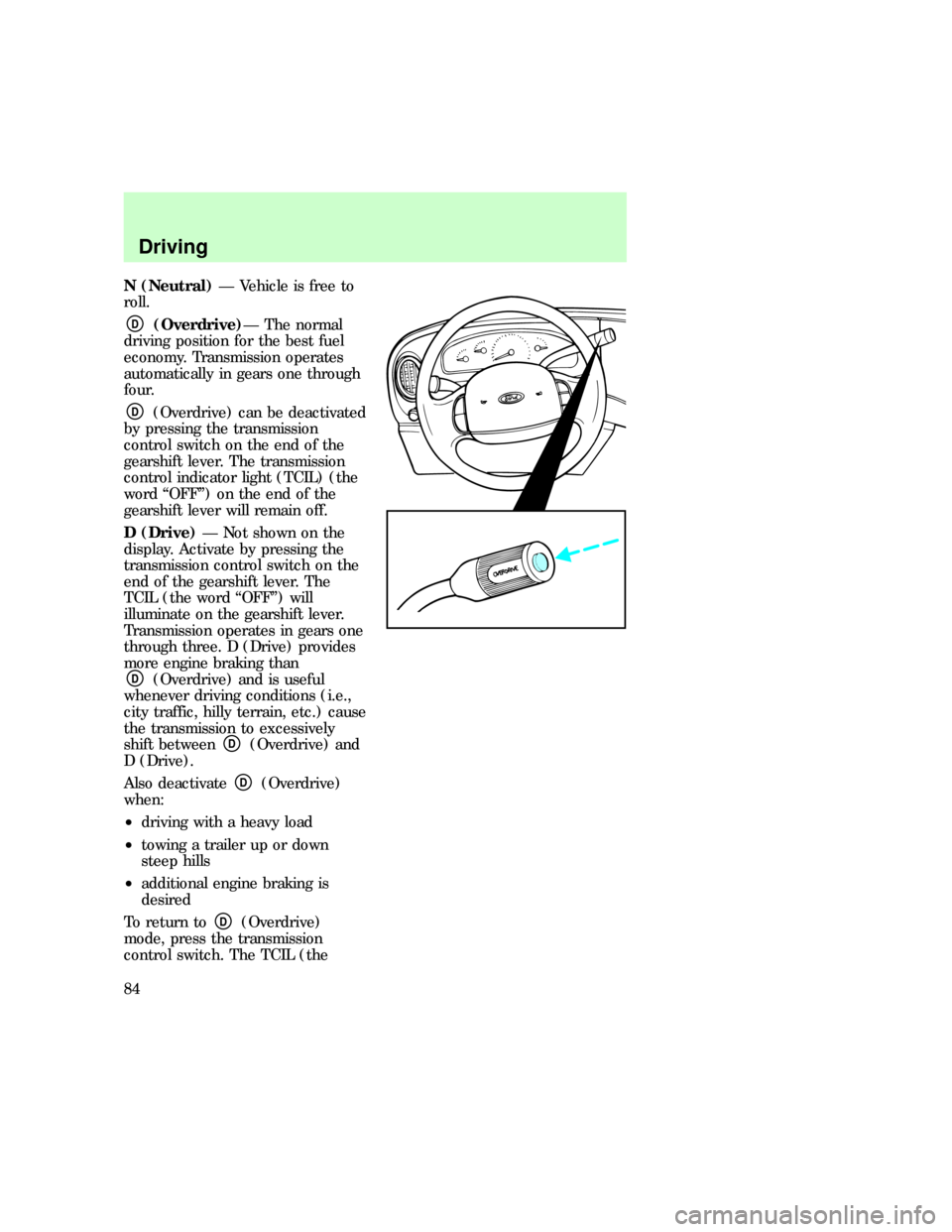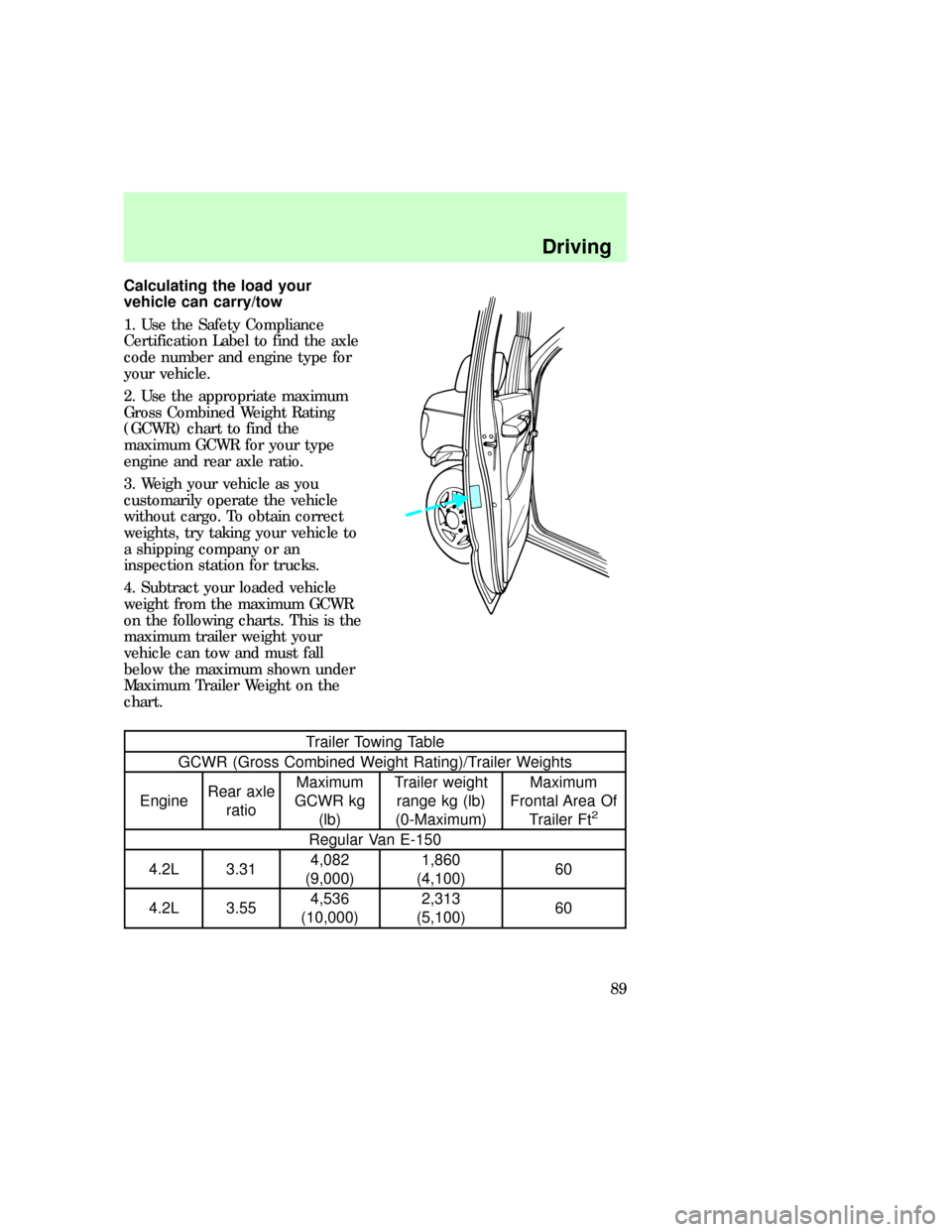Page 84 of 192

N (Neutral)Ð Vehicle is free to
roll.
D(Overdrive)Ð The normal
driving position for the best fuel
economy. Transmission operates
automatically in gears one through
four.
D(Overdrive) can be deactivated
by pressing the transmission
control switch on the end of the
gearshift lever. The transmission
control indicator light (TCIL) (the
word ªOFFº) on the end of the
gearshift lever will remain off.
D (Drive)Ð Not shown on the
display. Activate by pressing the
transmission control switch on the
end of the gearshift lever. The
TCIL (the word ªOFFº) will
illuminate on the gearshift lever.
Transmission operates in gears one
through three. D (Drive) provides
more engine braking than
D(Overdrive) and is useful
whenever driving conditions (i.e.,
city traffic, hilly terrain, etc.) cause
the transmission to excessively
shift between
D(Overdrive) and
D (Drive).
Also deactivate
D(Overdrive)
when:
²driving with a heavy load
²towing a trailer up or down
steep hills
²additional engine braking is
desired
To return to
D(Overdrive)
mode, press the transmission
control switch. The TCIL (the
Driving
84
Page 85 of 192

word ªOFFº) will no longer be
illuminated.
Each time the vehicle is started,
the transmission will automatically
return to normal overdrive mode
and you must press the TCS to
deactivate overdrive again if you
do not want overdrive operation.
2 (Second)Ð Use 2 (Second) to
start-up on slippery roads or to
provide additional engine braking
on downgrades. Transmission
operates in first and second gears.
1 (Low)Ð Use 1 (Low) to
provide maximum engine braking
on steep downgrades. Upshifts can
be made by shifting to 2 (Second)
or to
D(Overdrive). Selecting 1
(Low) at higher speeds causes a
shift to 2 (Second), and will shift
to 1 (Low) after vehicle
decelerates to the proper speed.
Brake-shift interlock
The brake-shift interlock feature
prevents you from shifting from P
(Park) unless the brake pedal is
depressed (with the ignition in the
ON position). If you cannot move
the gearshift out of P (Park) with
the brake pedal depressed:
1. Turn ignition key to Off.
2. Apply the parking brake.
3. Turn ignition key to Lock and
remove the key.
4. Re-insert the ignition key and
turn it to Off.
eco_brake_shift_inter-lock
Driving
85
Page 89 of 192

Calculating the load your
vehicle can carry/tow
1. Use the Safety Compliance
Certification Label to find the axle
code number and engine type for
your vehicle.
2. Use the appropriate maximum
Gross Combined Weight Rating
(GCWR) chart to find the
maximum GCWR for your type
engine and rear axle ratio.
3. Weigh your vehicle as you
customarily operate the vehicle
without cargo. To obtain correct
weights, try taking your vehicle to
a shipping company or an
inspection station for trucks.
4. Subtract your loaded vehicle
weight from the maximum GCWR
on the following charts. This is the
maximum trailer weight your
vehicle can tow and must fall
below the maximum shown under
Maximum Trailer Weight on the
chart.
Trailer Towing Table
GCWR (Gross Combined Weight Rating)/Trailer Weights
EngineRear axle
ratioMaximum
GCWR kg
(lb)Trailer weight
range kg (lb)
(0-Maximum)Maximum
Frontal Area Of
Trailer Ft
2
Regular Van E-150
4.2L 3.314,082
(9,000)1,860
(4,100)60
4.2L 3.554,536
(10,000)2,313
(5,100)60
Driving
89
Page 90 of 192
Trailer Towing Table
GCWR (Gross Combined Weight Rating)/Trailer Weights
EngineRear axle
ratioMaximum
GCWR kg
(lb)Trailer weight
range kg (lb)
(0-Maximum)Maximum
Frontal Area Of
Trailer Ft
2
4.6L 3.314,990
(11,000)2,766
(6,100)60
4.6L 3.555,216
(11,500)2,993
(6,600)60
5.4L 3.555,443
(12,000)3,130
(6,900)60
Regular Van E-250
4.2L 3.734,763
(10,500)2,359
(5,200)60
5.4L 3.735,897
(13,000)3,402
(7,500)60
Regular Van E-250 HD
4.2L 4.094,990
(11,000)2,586
(5,700)60
5.4L 3.735,897
(13,000)3,402
(7,500)60
Super Van E-250
4.2L 3.734,763
(10,500)2,313
(5,100)60
5.4L 3.735,897
(13,000)3,357
(7,400)60
Super Van E-250 HD
4.2L 4.094,990
(11,000)2,540
(5,600)60
5.4L 3.735,897
(13,000)3,356
(7,400)60
Regular Van E-350
5.4L 3.555,443
(12,000)2,948
(6,500)60
Driving
90
Page 91 of 192
Trailer Towing Table
GCWR (Gross Combined Weight Rating)/Trailer Weights
EngineRear axle
ratioMaximum
GCWR kg
(lb)Trailer weight
range kg (lb)
(0-Maximum)Maximum
Frontal Area Of
Trailer Ft
2
5.4L 4.105,897
(13,000)3,402
(7,500)60
7.3L
(Diesel)3.557,258
(16,000)4,536
(10,000)60
7.3L
(Diesel)4.109,072
(20,000)4,536
(10,000)60
6.8L 3.736,804
(15,000)4,218
(9,300)60
6.8L 4.108,392
(18,500)4,536
(10,000)60
Super Van E-350
5.4L 3.555,443
(12,000)2,858
(6,300)60
5.4L 4.105,897
(13,000)3,311
(7,300)60
7.3L
(Diesel)3.557,258
(16,000)4,445
(9,800)60
7.3L
(Diesel)4.109,072
(20,000)4,536
(10,000)60
6.8L 3.736,804
(15,000)4,173
(9,200)60
6.8L 4.108,392
(18,500)4,536
(10,000)60
Club Wagon E-150 (8 passenger)
4.2L 3.314,082
(9,000)1,678
(3,700)60
4.2L 3.554,536
(10,000)2,132
(4,700)60
Driving
91
Page 92 of 192
Trailer Towing Table
GCWR (Gross Combined Weight Rating)/Trailer Weights
EngineRear axle
ratioMaximum
GCWR kg
(lb)Trailer weight
range kg (lb)
(0-Maximum)Maximum
Frontal Area Of
Trailer Ft
2
4.6L 3.314,990
(11,000)2,540
(5,600)60
4.6L 3.555,216
(11,500)2,767
(6,100)60
5.4L 3.555,443
(12,000)2,948
(6,500)60
Club Wagon Regular E-350 (12 passenger)
5.4L 3.555,443
(12,000)2,722
(6,000)60
5.4L 4.105,897
(13,000)3,175
(7,000)60
7.3L
(Diesel)3.557,258
(16,000)4,309
(9,500)60
7.3L
(Diesel)4.109,072
(20,000)4,536
(10,000)60
6.8L 3.736,804
(15,000)4,037
(8,900)60
6.8L 4.108,392
(18,500)4,536
(10,000)60
Club Wagon Super E-350 (15 passenger)
5.4L 3.555,443
(12,000)2,586
(5,700)60
5.4L 4.105,897
(13,000)3,039
(6,700)60
7.3L
(Diesel)3.557,258
(16,000)4,173
(9,200)60
7.3L
(Diesel)4.109,072
(20,000)4,536
(10,000)60
Driving
92
Page 93 of 192
Trailer Towing Table
GCWR (Gross Combined Weight Rating)/Trailer Weights
EngineRear axle
ratioMaximum
GCWR kg
(lb)Trailer weight
range kg (lb)
(0-Maximum)Maximum
Frontal Area Of
Trailer Ft
2
6.8L 3.736,804
(15,000)3,901
(8,600)60
6.8L 4.108,392
(18,500)4,536
(10,000)60
E-350 RV Cutaway (single rear wheel)
7.3L
(Diesel)4.109,072
(20,000)4,717
(10,400)60
E-350 RV Cutaway (dual rear wheel)
5.4L 4.105,897
(13,000)1,134
(2,500)60
6.8L 4.108,392
(18,500)3,629
(8,000)60
7.3L
(Diesel)4.109,072
(20,000)4,309
(9,500)60
E-350 Commercial Cutaway (single rear wheel)
7.3L
(Diesel)4.109,072
(20,000)4,717
(10,400)60
E-350 Commercial Cutaway (dual rear wheel)
5.4L 4.105,897
(13,000)1,225
(2,700)60
6.8L 4.108,392
(18,500)3,720
(8,200)60
7.3L
(Diesel)4.109,072
(20,000)4,400
(9,700)60
E-Super Duty
6.8L 4.639,072
(20,000)4,536
(10,000)60
7.3L
(Diesel)4.639,072
(20,000)4,536
(10,000)60
Driving
93
Page 94 of 192

Trailer Towing Table
GCWR (Gross Combined Weight Rating)/Trailer Weights
EngineRear axle
ratioMaximum
GCWR kg
(lb)Trailer weight
range kg (lb)
(0-Maximum)Maximum
Frontal Area Of
Trailer Ft
2
E-250/350 Stripped Chassis (single rear wheel)
5.4L 4.105,897
(13,000)1,542
(3,400)60
6.8L 3.736,804
(15,000)2,540
(5,600)60
E-250/350 Stripped Chassis (dual rear wheel)
5.4L 4.105,897
(13,000)1,361
(3,000)60
6.8L 4.108,392
(18,500)3,856
(8,500)60
For high altitude operation, reduce GCWR by 2% per 300 meters
(1,000 ft) elevation.
To determine the maximum trailer weight designed for you particular
vehicle as equipped, follow the section Calculating the load your
vehicle can tow/carryearlier in this chapter.
TRAILER TOWING
Your vehicle may tow a class I, II
or III trailer provided the
maximum trailer weight is less
than or equal to the maximum
trailer weight listed for your engine
and rear axle ratio on the above
charts.
Your vehicle's load capacity is
designated by weight, not by
volume, so you cannot necessarily
use all available space when
loading a vehicle.
Distribute the load so that only 10
to 15% of the total is on the
tongue. Tie down the load so that
eco_trailer
Driving
94